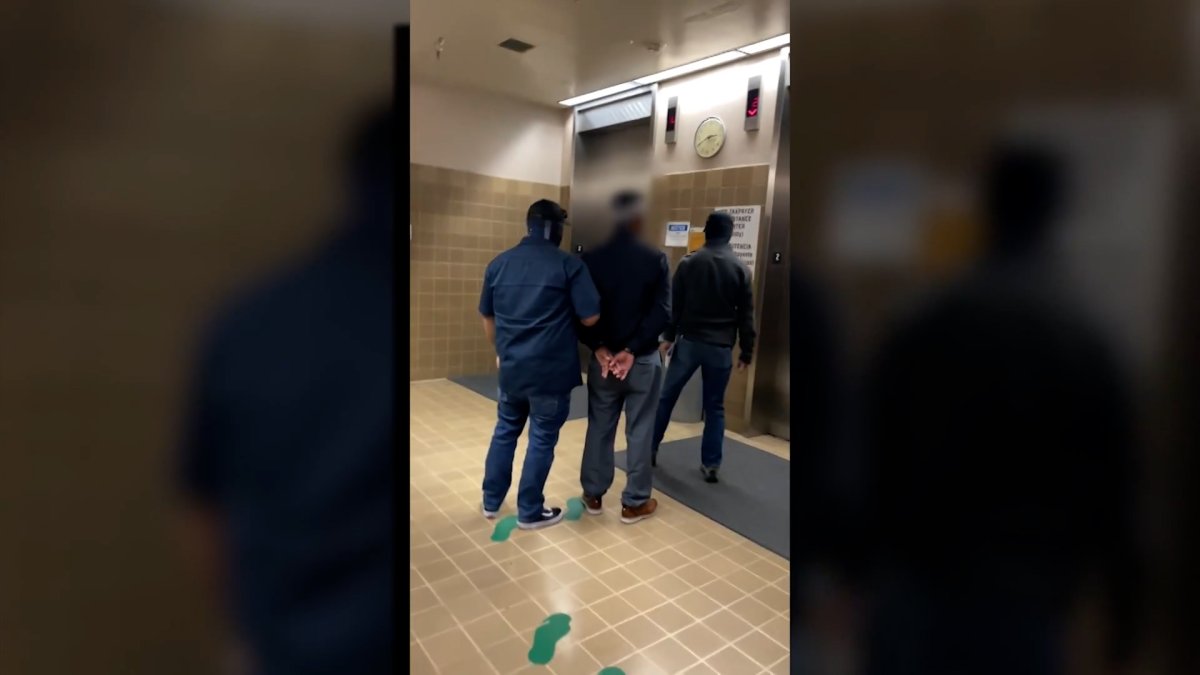U.S. Immigration and Customs Enforcement has begun detaining more people during check-ins at the federal building in downtown San Diego in recent days — an apparent shift in strategy after arrests outside courtrooms had slowed over the past month.
The spike began last Thursday, when volunteer observers said ICE agents detained at least 11 people. ICE took 10 people into custody on Friday, 13 on Tuesday and another 10 on Wednesday for a total of 44 people in four days, according to the volunteers.
Those detentions took place on the second floor, where the agency’s check-in office is located. Some of those people taken into custody came for ICE check-ins, while others were told to check in after an immigration court hearing on the fourth floor.
“My understanding from the ICE officers is that it’s a directive from the administration to detain everybody,” said immigration attorney Valerie Sigamani. “People who have children, the families are going to be heavily impacted, and people that have medical issues are what we fear the most being detained.”
Sigamani said many of the people she’s seen detained, including her clients, had their immigration cases administratively closed years ago – sometimes decades – when the federal government decided they were not a priority for deportation. But their cases have since been recalendared (basically put back on the docket) under President Donald Trump’s administration, and some taken into custody, even if they have pending applications to adjust their status.
Faithful Accompaniment in Trust & Hope (FAITH) leaders have recruited about 300 volunteers to accompany people to immigration hearings after mass deportation efforts, reports NBC 7’s Shelby Bremer.
One those people detained Thursday was Fidel Sanchez Avalos, who has been in the U.S. for more than 30 years. He said before his hearing that he was nervous and scared.
“Every day we live in fear,” his U.S. citizen daughter Lizbeth Sanchez said. “He’s always working, even when they were saying that they would stop people just for the way you looked. I mean, we were always in fear, but he had to go to work.”
During the hearing, Sanchez Avalos’ attorney said they were working on a visa application for him and the judge set the next hearing date for January. Afterwards, he waited for his check-in for several hours, only to learn he was being detained. His family left the federal building in tears.
Two others detained Thursday were the parents of a U.S. Marine, who were first taken into custody while trying to visit their daughter at Camp Pendleton, then released on ankle monitors and told to check in with ICE, where they were led away again. The father was deported Friday, his son said.
One 18-year-old American citizen, who asked not to be identified, showed up to the federal building Wednesday because he said his uncle had a hearing the day before and never came home.
“I was scared. All my family was scared, really,” he said. “I was hoping maybe anything, anything but being detained.”
He said his uncle has been in the U.S. for 19 years and became a single father of 2-year-old twin boys when his wife died in childbirth. He learned Wednesday that his uncle had been detained, and he is now helping care for the babies.
“I don’t think I’ve ever been so mad in my life after today, really,” he said. “Mostly worried about his two kids not growing up with their father, which I don’t want them to go through that because they already lost their mother.”
“If they’re not with the parents, like constantly, they might forget who they are,” he continued. “And so it just kind of hurts. I don’t want my baby cousins to forget their father.”
Detentions outside immigration courtrooms had fallen in recent weeks after a court order out of Washington, D.C., in late August blocked the nationwide expansion of expedited removal — basically, a faster deportation process that does not require a hearing before a judge.
But as detentions at check-ins now rise, immigration attorneys, volunteers and families of detainees said many taken into custody have been held in the basement of the federal building for somewhere around two to five days because the Otay Mesa Detention Center is at capacity. But they contended the basement is not equipped for holding people for that length of time, without real beds or showers.
The people held in the basement also do not show up in ICE’s online detainee locator, which families said has caused them great fear.
“Of course it’s panic, because they’re thinking, ‘I don’t know how to reach my family,’” Sigamani said.
An ICE spokesperson did not answer questions on how many people are being detained in the basement in San Diego or about the uptick in detentions overall. The agency did say the building is a “well-equipped processing facility where all detainees are provided access to meals, water, snacks, telephones, and the ability to contact their consulate or legal representation.”
“Individuals are held in this processing area for the minimum amount of time necessary to complete processing and determine the most appropriate housing location based on their specific needs,” the statement continued. “Key factors such as medical requirements, removability status, and available bed space are carefully considered to ensure the best possible placement.”
Faith leaders are among the volunteers escorting people and bearing witness.
“I feel very sad,” said Fr. Alejandro Olayo-Mendez, a Jesuit priest. “I feel a deep sadness and I feel, I feel a lot of impotence about not being able to say anything, to speak up, to really be able to do something more concrete for these people to help them because they are suffering. It makes me angry.”

